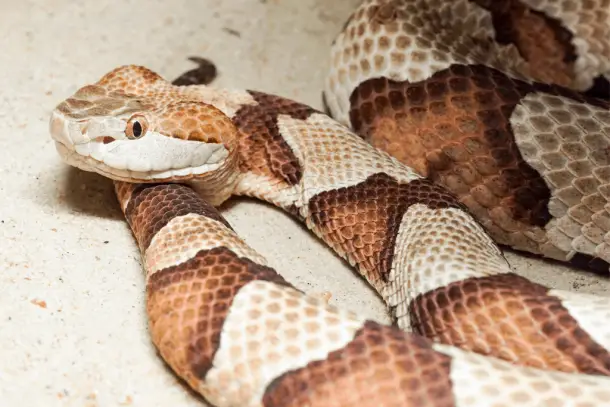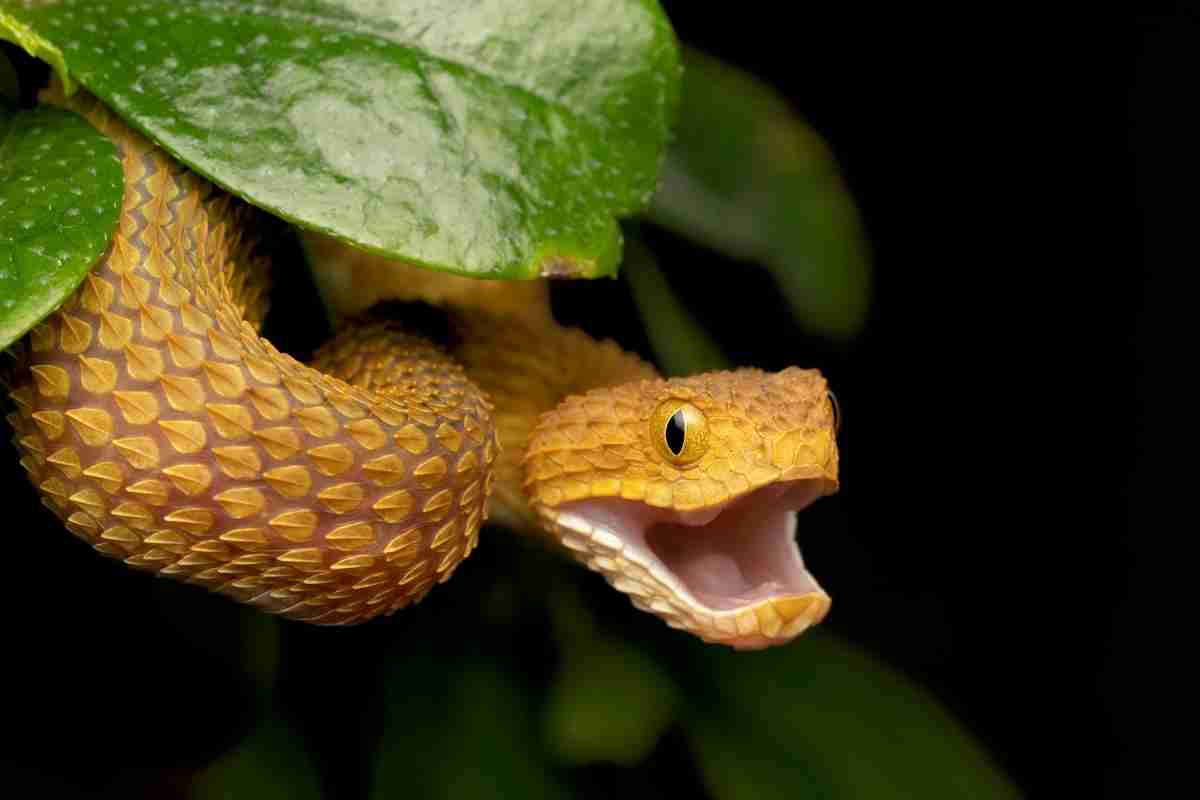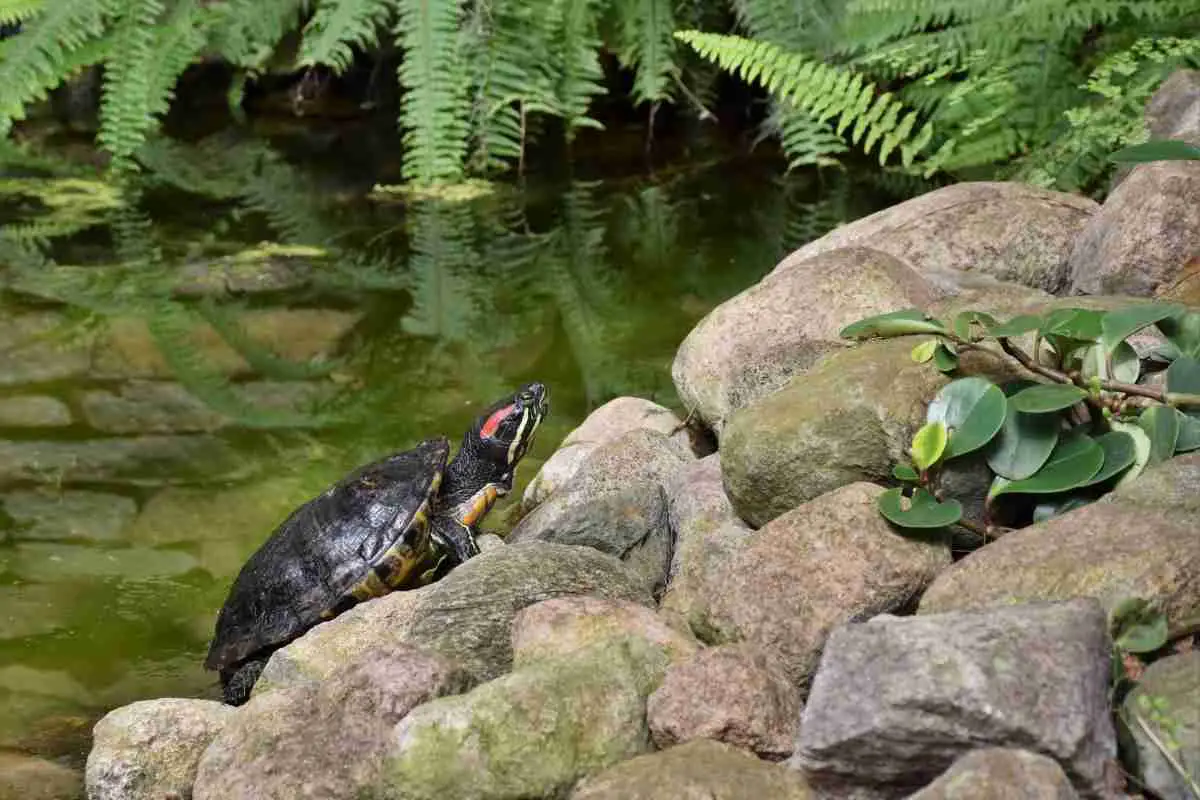Baby copperhead snakes are usually born in the late summer and their coloring is not much different from that of an adult copperhead. However, it can be difficult to know what you’re looking at when they are so small.
The good news is, baby copperheads have distinctive markings on their body so you can identify them. The bad news is, they can be poisonous so you shouldn’t handle the snake or get too close.
To help you solve this problem, here is a quick guide to explain in detail how to identify these snakes so by the time you get to the end of this article you will know exactly what a baby copperhead snake looks like.
What Do Baby Copperhead Snakes Look Like?
What Do Baby Copperhead Snakes Look Like? Baby copperhead snakes are born 7 to 9 inches long with a copperhead pattern on their head and body and look very similar to adults! However, young copperheads will be greyer and have a bright yellow-colored tail.
It’s very important if you come across a baby copperhead in the wild not to touch it as it can be poisonous “maybe not as much as the adults” but if you have been bitten there is that chance it could be fatal.
This blog post will help you identify a baby copperhead which is in fact the most common type of snake in North America. If you come across and see a small snake it is more than likely safe to assume that it’s harmless.
However, if it turns out to be a baby or adult copperhead snake then you should steer clear of it as these snakes can be dangerous and struck if feel threatened or provoked.
How To Identify a Baby Copperhead?
One of the most common ways to identify a copperhead is by looking at its pattern and shape. When babies are born, they also have bright yellow-tipped tails adults copperheads don’t.
The black splotches are wider on each side, forming an hourglass-like design with darker shading in between them.
This dark coloring will be much more pronounced near the top where it forms two bright reddish triangles (either one or both) that resemble eyes peeking out from either end of the snake’s head.
Copperheads are poisonous so it’s not a good idea to have one as a pet. So if you are bitten by a baby copperhead, it’s important to seek medical attention as soon as possible.
Identifying A Baby Copperhead
- Bright Yellow-Tipped Tail
- Red & Copper Colored Head
- Look For Two Dark Spots On The Top Of The Head
- Check For Black Splotches On Both Sides Of The Snake
Baby Copperhead Colors
The body of a copperhead has a slight light tan. Sometimes baby copperheads are grayer than adults, but turn a more brownish color as they age. Along the back of their head is dark reddish-brown markings
Copperheads are the only type of snake that has copper-colored heads, which is how they got their name. Baby copperheads are slightly darker at birth, but will eventually lighten to the same shade as an adult.
They also have a lighter, patchy belly with dark markings. The coloration of the copperhead’s underbelly is usually different from that on its backside and it may also contain patches or rough surfaces.
As they grow older, their coloring will change and become lighter. Young copperheads that have just hatched from eggs may be more gray-colored on top of their heads and bodies when compared to adults which have deep reds mixed into them.
The baby copperhead’s tail will change over time. As they age, the yellow color gradually fades to a more earthy brown or red which the snake will use to its advantage by fooling and luring its prey thinking its a worm.
Baby Copperhead Colors
- Their Head has Dark Reddish-Brown Markings
- Patchy Belly With Dark Gray Batches
- A Slightly Tan Head And Body
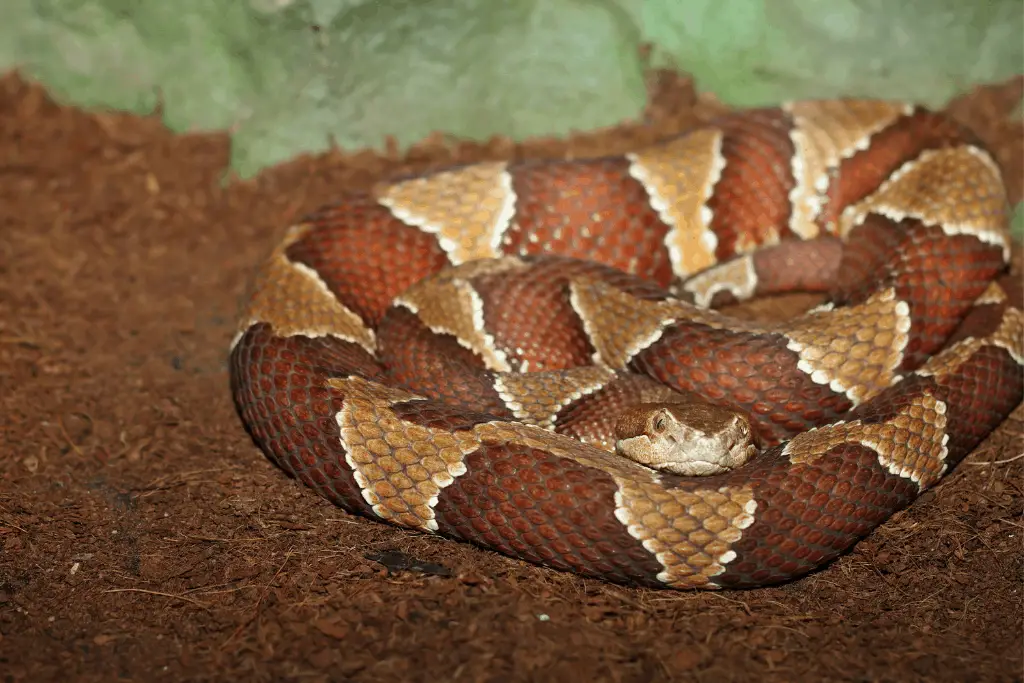
Other Ways To Identify A Baby Copperhead
A baby copperhead is a snake that has some unique features for starters baby and adult copperhead’s head is shaped similar to that of a heart when viewed from above, which means they can be identified by this trait alone.
Other snakes look different with narrower or rounder heads, making it easy for them to distinguish between various kinds in comparison to a baby copperhead.
Copperheads are also pit vipers, which means they hunt with the help of two slits between their eyes and nostrils. These slits aid in sensing thermal radiation from prey even when it is a slight change in temperature.
The copperhead uses this feature to learn how close its next meal is by feeling for any changes that happen near them, Copperheads aren’t the only snakes who have these features, rattlesnakes and water moccasins are other examples of pit vipers as well!
The copperhead uses its ability to learn how close prey it by following changes in temperature patterns around it using such features like those found on all other pits viper species.
Pit vipers are known for their heat-sensing abilities, so they use these to know when the prey is nearby following changes in temperature patterns around them using such features like their eyes.
Baby copperheads have elliptical yellow eyes, meaning their pupils are slit and not round. This is an adaptation that helps them see better in low light conditions which makes it easier for them to hunt at night or during the day.
They can also strike out with incredible speed! These snakes hunt primarily during nighttime hours or dusk/dawn periods of time just before daylight hits.
This is because their thermal-sensitive pits do not work well under direct sunlight due to the change in temperatures that occurs without any way for them to detect.
Other Ways To Identify A Baby Copperhead
- Heart-Shaped Head
- Elliptical yellow eyes
- Two Slits Between The Eyes & Nostrils.
Are Baby Copperhead Snakes Poisonous?
Yes, baby copperheads are poisonous, just like adult copperheads. All copperheads are venomous and inject their prey with a neurotoxin that acts quickly to paralyze the victim.
Though a baby is likely to release less venom than an adult copperhead, be careful if you’re near one. It may still attack and bite even though it does not seem very dangerous on its own!
Many people who keep pet snakes often wonder if their young copperhead snakes are dangerous. While a baby is not as venomous as an adult, it can still pose a danger.
If you are bitten by a baby copperhead the venom can be very painful although the snake won’t deliver as much venom as an adult you should still seek medical attention as soon as possible.
Related Article:
Other Snakes That Look Similar To A Copperhead
Copperhead snakes are very similar in appearance to other types of venomous and non-venomous snakes, it’s important that you know the difference between a copperhead snake and some other types of poisonous snakes.
Here is a list of other types of snakes that might look very similar to the copperhead snake…
Northern Water Snakes have darker crossbands that extend from head to tail. This snake is very similar and often mistaken for copperheads due to their similar pattern.
However, the way you can separate these species is the shape of their heads. The northern water snake has a narrower head yet the copperhead has a heart-shaped head!
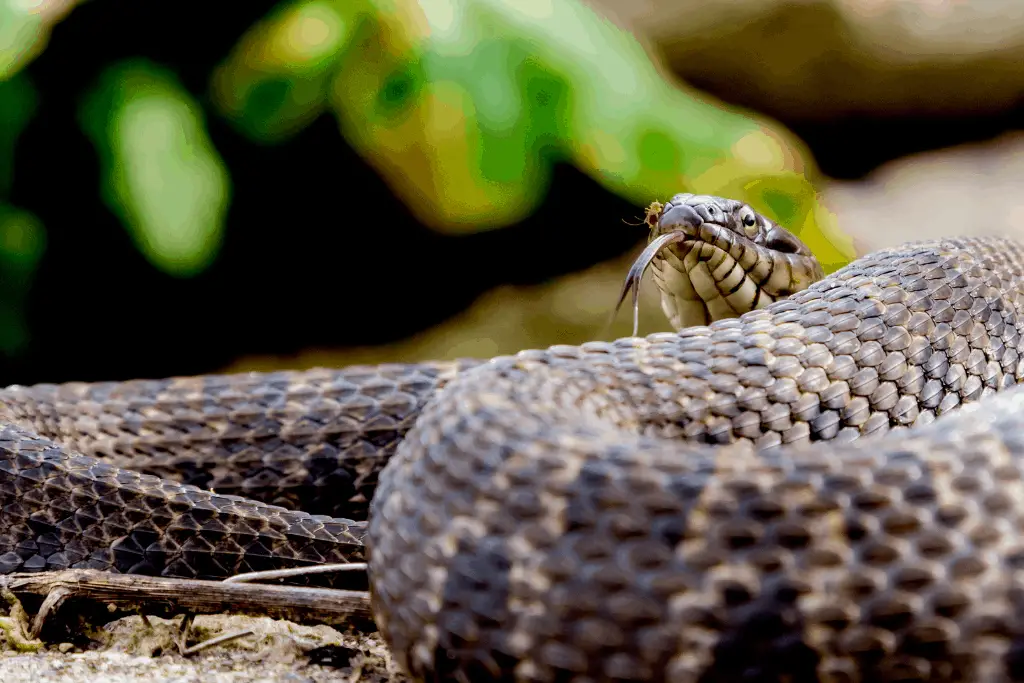
Mole kingsnakes are one of the most common species in North America. They have a black stripe that runs down their body from head to tail.
They look similar to baby copperhead heads as they are slightly tanned and darker, however, the mole kingsnake has black eyes and the head is smaller than the copperhead.
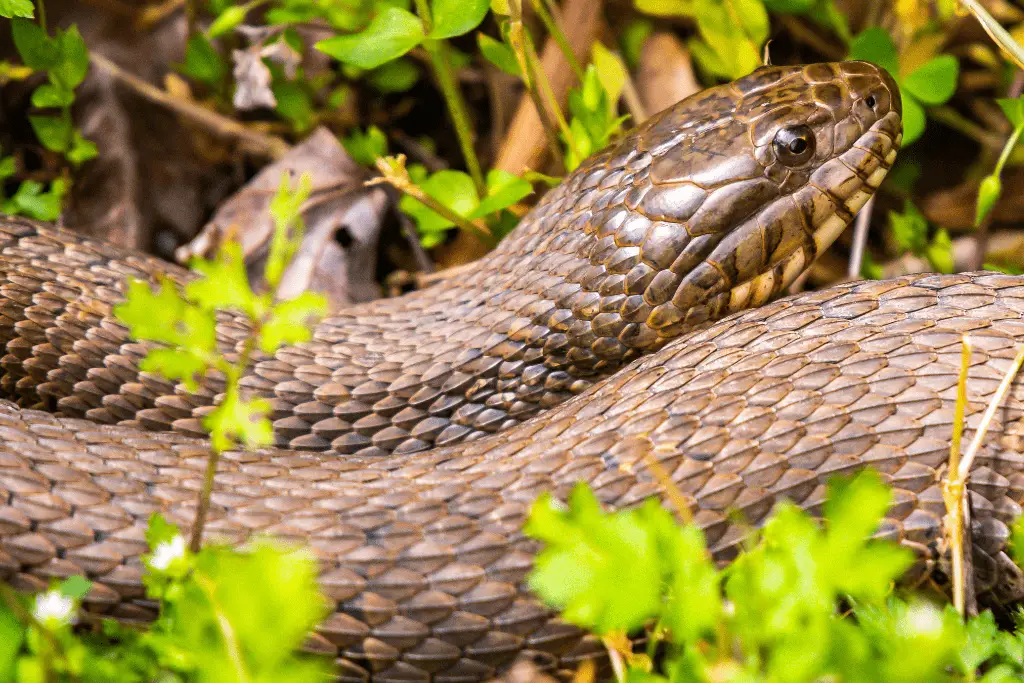
Eastern Hognose Snakes are known for their upturned nose and flicking tongue. They range in color from light tan to dark brown with a white underside on the belly.
The color and patten of both the hognose snake and baby copperhead are quite similar, however, the hognose snake has a wider head and the color is much darker.
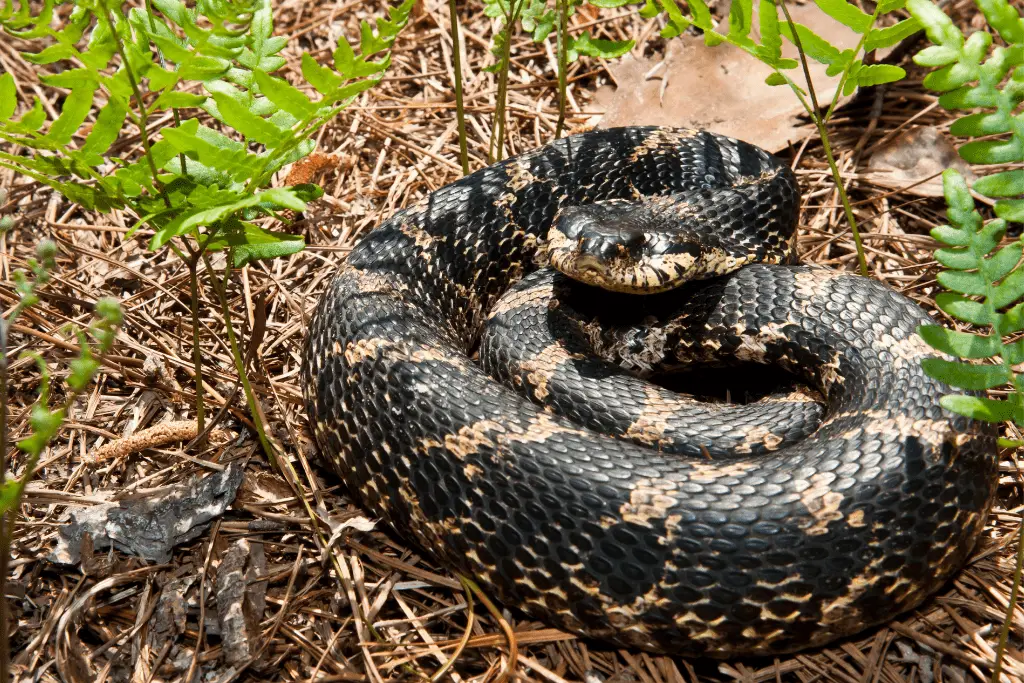
Black Racer Snakes are a type of snake that has many different colors. They have light brown, dark brown, and black bands on their skin. They are known for being fast and grow up to 4 feet in length.
They’re often mistaken for baby copperheads because of their dark coloration and the fact that they live in the same habitats as copperheads do.
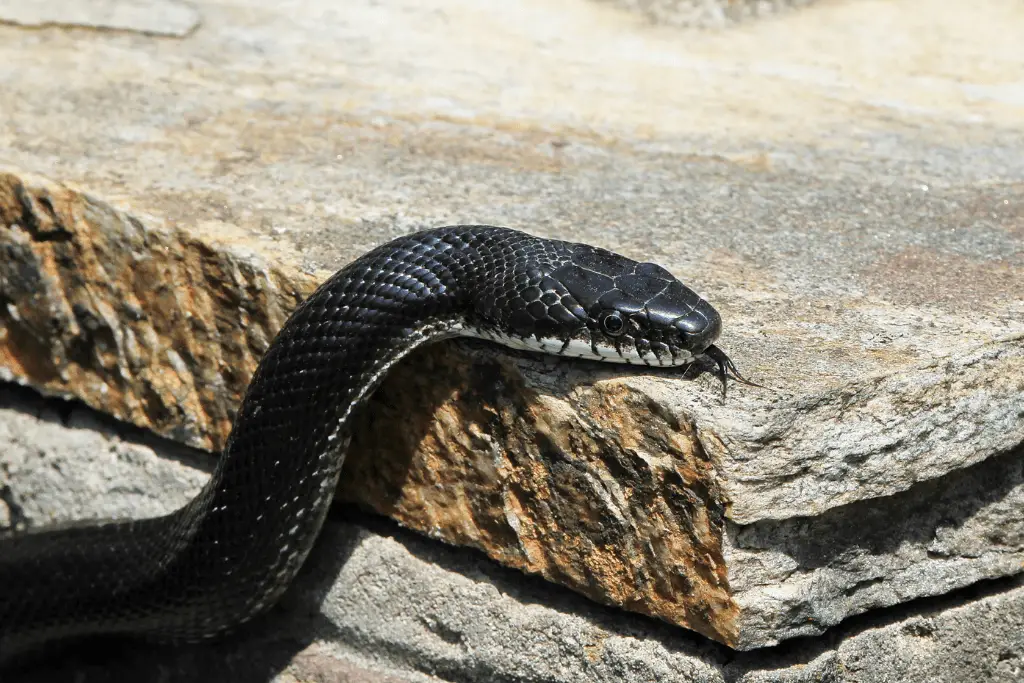
Corn Snakes come in a variety of colors. These include combinations of reds, oranges, yellows, and browns with some species like the calico corn snake having stripes or spots on their skin.
What’s very similar to the copperhead is the corn snake color and pattern, however, what separates them both is the corn snake has round eyes and has no hourglass-shaped on its back.
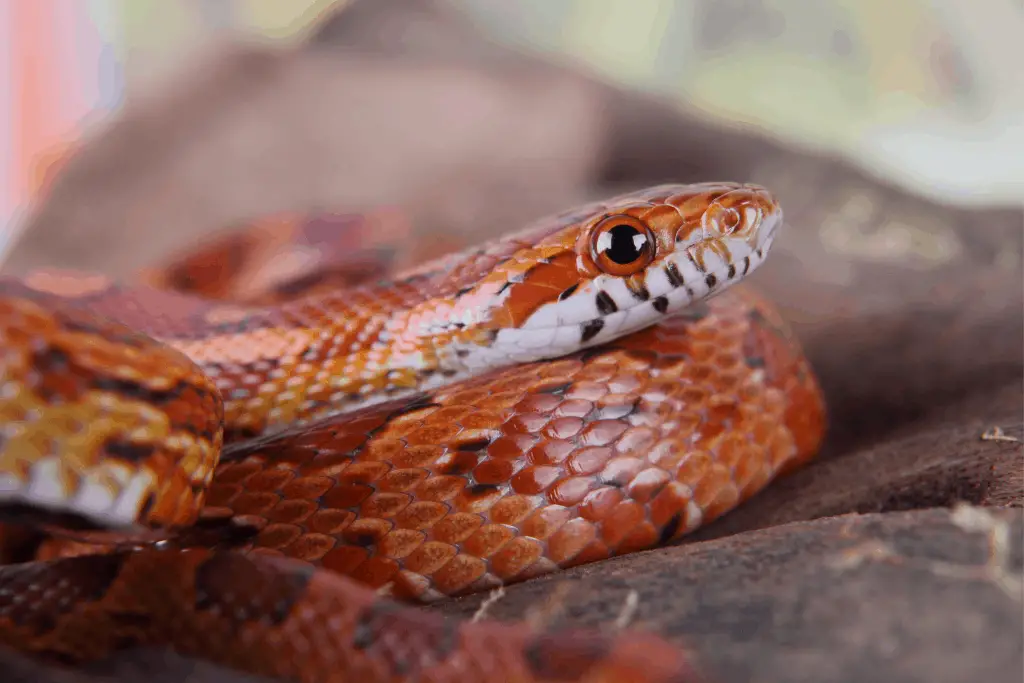
If you have a snake roaming in your back yard or garden with these identifying marks then it is possible your looking at a copperhead snake!
How To Safely Remove Baby Copperheads
In order to remove a copperhead in your yard, it is important that you choose the right tool for the job. Copperheads can be aggressive if provoked and can strike out if threatened.
They will often slither away on their own without human intervention as long as they feel comfortable near where they were found. But only observe them from a far and always use caution!
Safety Tip: Using a hook is a useful device for handling and removing Copperhead snakes. This will provide you with valuable distance and prevents them from biting you.
The point should always go underneath the middle of the baby copperhead’s body so they are unable to slip away easily – this method will keep both of you safe!
You should place the snake in a large bucket that has a small air hole so the snake can breathe and then send it to your local reptile shop or vet. Alternatively, you can use two sticks however this won’t be as effective as a hook.
Preventing Copperhead Snakes from entering your yard
Copperheads are one type of snake that can be found in yards and gardens all over the United States. These snakes typically stay within their own territory, but they will occasionally venture into other areas if it’s warmer.
There are a few things you can do to make sure copperheads don’t come into your yard including trimming bushes so that there aren’t any places where snakes could hide.
Another thing and most important factor in preventing snakes from entering your yard is the grass! Snakes love long grass and frequently mowing the lawn will prevent them from crawling through the grass.
Long grass provides hiding places for baby copperheads! To prevent that problem altogether you can use snake repellant much like you would use from cats that are not harmful it just gives off a smell that is unbearable to be around.
Another way to prevent these snakes from entering your yard is by sealing up any gaps that may lead them inside using a concrete sealant. You should also make sure there is no debris piled up against your fence panels.
Conclusion
So now know What Baby Copperhead Snakes Look Like? Knowing how to identify a baby copperhead will help you understand when it is time for action. When attempting removal make sure your tools and methods are safe.
Using hooks, grab sticks work well on these snakes. But be gentle with them as much as yourself – slow movements allow both parties involved to feel calmer in an admittedly stressful situation.
Copperheads can strike quickly, and there have even been cases where people were bitten by a copperhead on their foot while wearing sandals so make sure you protect your feet.
Just remember baby copperhead snakes are venomous, so it’s important to exercise caution when confronting or trying to catch one. Catching a snake in the wild is not an easy task.
Related Article

